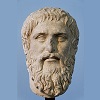7.5: Successor Kingdoms to the Western Roman Empire
- Page ID
- 1216
The Germanic peoples who had invaded the Roman Empire over the course of the fifth century had, by the early 500s, established a set of kingdoms in what had been the Western Empire. The Vandals ruled North Africa in a kingdom centered on Carthage, a kingdom whose pirates threatened the Mediterranean for nearly eighty years. The Visigoths ruled Spain in a kingdom that preserved many elements of Roman culture. In Italy, the Roman general Odavacar had established his own kingdom in 476 before being murdered by the Ostrogoth king Theodoric, who established a kingdom for his people in Italy, which he ruled from 493 to his death in 526. Vandal, Visigoth, and Ostrogoth peoples all had cultures that had been heavily influenced over decades or even centuries of contact with Rome. Most of them were Christians, but, crucially, they were not Catholic Christians, who believed in the doctrine of the Trinity, that God is one God but three distinct persons of the Father, the Son (Jesus Christ), and the Holy Spirit. They were rather Arians, who believed that Jesus was lesser than God the Father (see Chapter Six). Most of their subjects, however, were Catholics.
The Catholic Church increasingly looked to the bishop of Rome for leadership. Over the fifth century, the bishop of Rome had gradually come to take on an increasing level of prestige among other bishops. Rome had been the city where Peter, whom tradition regarded as the chief of Christ’s disciples, had ended his life as a martyr. Moreover, even though the power of the Western Roman Empire crumbled over the course of the 400s, the city of Rome itself remained prestigious. As such, by the fourth and fifth centuries, the bishops of Rome were often given the title of papa, Latin for “father,” a term that we translate into pope. Gradually, the popes came to be seen as having a role of leadership within the wider Church, although they did not have the monarchial authority that later popes would claim.
.png?revision=1)
In the region of Gaul, the Franks were a Germanic people who had fought as mercenaries in the later Roman Empire and then, with the disintegration of the Western Empire, had established their own kingdom. One key reason for the Frankish kingdom’s success was that its kings received their legitimacy from the Church. In the same way that the Christian Church had endorsed the Roman Emperors since Constantine and, in return, these emperors supported the Church, the Frankish kings took up a similar relation with the Christian religion. King Clovis (r. 481 – 509) united the Franks into a kingdom, and, in 496, converted to Christianity. More importantly, he converted to the Catholic Christianity of his subjects in post-Roman Gaul. This would put the Franks in sharp contrast with the Vandals, Visigoths, and Ostrogoths, all of whom were Arians.
In none of these kingdoms, Visigothic, Ostrogothic, Frankish, or Vandal, did the Germanic peoples who ruled them seek to destroy Roman society—far from it. Rather, they sought homelands and to live as the elites of the Roman Empire had done before them. Theodoric, the king of the Ostrogoths (r. 493 – 526), had told his people to “obey Roman customs… [and] clothe [them] selves in the morals of the toga.”1 Indeed, in the generations after the end of the Western Empire in the late 400s, an urban, literate culture continued to flourish in Spain, Italy, and parts of Gaul. The Germanic peoples often took up a place as elites in the society of what had been Roman provinces, living in rural villas with large estates. Local elites shifted their allegiances from the vanished Roman Empire to their new rulers. In many ways, the situation of Western Europe was analogous to that of the successor states of the Han Dynasty such as Northern Wei, in which an invader took up a position as the society’s new warrior aristocracy (see Chapter Four).
But even though the Germanic kings of Western Europe had sought to simply rule in the place of (or along with) their Roman predecessors, many of the features that had characterized Western Europe under the Romans—populous cities; a large, literate population; a complex infrastructure of roads and aqueducts; and the complex bureaucracy of a centralized state—vanished over the course of the sixth century. Cities shrank drastically, and in those regions of Gaul north of the Loire River, they nearly all vanished in a process that we call ruralization. As Europe ruralized and elite values came to reflect warfare rather than literature, schools gradually vanished, leaving the Church as the only real institution providing education. So too did the tax-collecting apparatus of the Roman state gradually wither in the Germanic kingdoms. The Europe of 500 may have looked a lot like the Europe of 400, but the Europe of 600 was one that was poorer, more rural, and less literate.
1 Cassiodorus, Variae, trans. Thomas Hodgkin, in The Medieval Record: Sources of Medieval History, ed. Alfred J. Andrea (New York: Houghton Mifflin, 1997), 58.


